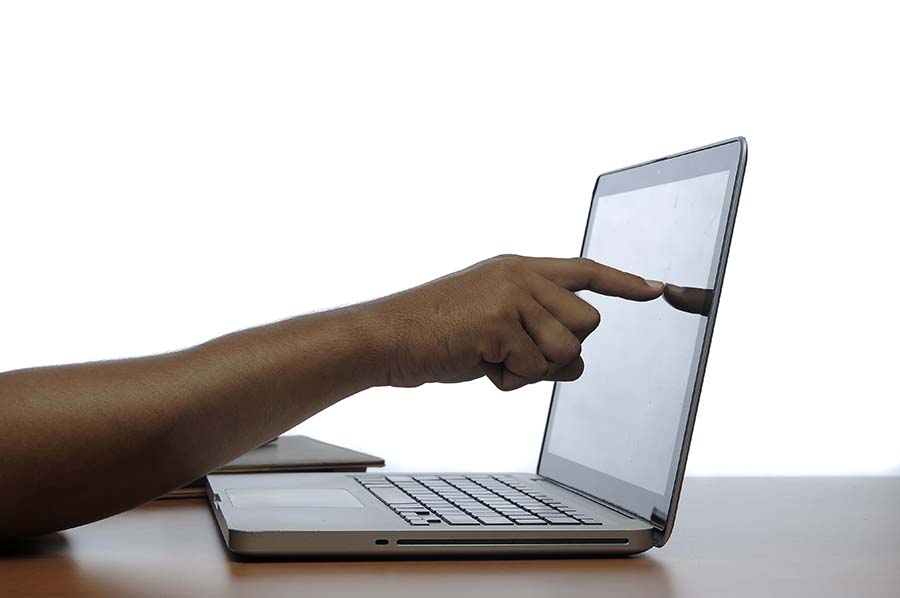Making the choice of purchasing a new laptop isn’t always easy. There’s tons of different options out there now, and it may even be worth looking at getting a touch screen laptop. In some cases, you may even have the choice to decide between a standard laptop and a touch version instead.
So, we’re going to take a quick look at whether opting for a touch enabled laptop a good idea, or whether you should stick with what you know.
Touch Screen vs Non Touch Screen Laptops
The idea of a touch screen laptop has long been contested by tech companies. You’ve probably noticed that both the Macbook Air and the Macbook Pro don’t have touchscreens, which might seem a little surprising seeing as Apple are usually at the forefront of technology and innovation.
As well as this, every other brand out there is releasing a touch screen laptop and selling them in good numbers. Examples are the Microsoft Surface series, Lenovo Yoga, Dell XPS, HP x360 and many more. There is consistent demand for touchscreen laptops, as proven over the last few years.
But Apple is still maintaining its stance of keeping the Macbook and the iPad as separate devices, and refuses to combine them together.
This might be due to the wishes of Steve Jobs, who famously said that a touchscreen laptop would be “ergonomically terrible”. And even Tim Cook too, who labelled the competition as “confused” when trying to combine the two.
But as mentioned earlier, now we have the iPad Pro from Apple. It’s essentially a tablet, but when you add in an additional keyboard, it’s as good of a touch screen laptop as most other alternatives. And the truth is that the data says that touchscreen laptops are popular.
So when you’re hunting for a new laptop, what should you be looking for? Here’s a few differences between the two, as well as what you will want to be looking for with a new touchscreen laptop.
How touch screen laptops are different

The difference between touchscreen and non-touchscreen laptops is that touchscreen models are much better for those who are interested in art and drawing, and they tend to have better displays with a higher resolution.
On the other hand, a non-touchscreen is cheaper, lighter and better on battery life. They’re some pretty key areas too, so it’s important to think about it before deciding to go for or against touch screen displays.
These are the core differences between the two. Having a touch screen usually means that your laptop will be a 2-in-1 too, which can double up as a tablet. This can make them more convenient, but as mentioned, there is a premium you’ll have to pay if you want this.
Let’s look at each of these reasons a little more and delve deeper into how exactly they differ.
Why to opt for a touchscreen laptop

If you’re not completely sold on touchscreen laptops, then there are a few reasons why you might want to opt for one. Here’s just a few of the main points of why you’d want a touchscreen.
Why not to go touch screen
Whilst there are several reasons why you might want to go for a touchscreen laptop, there also a few reasons why you might not want to as well.
Touchscreen laptops to check out
Now, if you are set on going for a touchscreen laptop, then there are many different options out there for you to choose from. Some of them are available in both a touch screen and a non touch screen option.
Here’s just a few of the top options to look for if you’re thinking about switching to using a touchscreen laptop.
Dell XPS 13/15
Out of the big name premium laptops (Macbook etc), the Dell XPS series is the first one to release a touchscreen version that you can opt for. It’s likely a sign of things to come, with the touchscreen XPS being pretty popular amongst users.
This is generally due to its high quality display and responsive design, which make it one of the best touchscreen laptops out there. Although you do may a premium to get integrated touch features into the display, you don’t sacrifice and picture quality or colour accuracy in doing so.
Microsoft Surface
The Microsoft Surface series is probably the most well known out there when considering touchscreen laptops and 2-in-1s; it’s really set the standard for other brands to have to try and meet.
Their laptops do tend to be expensive, but they usually come with a solid battery life and a high resolution which make it very visually impressive. Laptop models to check out are the Microsoft Surface Go, and the Surface Book 3, which has a display that’s completely detachable from the keyboard.
Razer Blade 15
Typically gaming laptops don’t come as touchscreen models, but you can upgrade this Razer model to have a 4K touchscreen display. When you combine this UHD touch display with a powerful processor, it makes for a laptop that’s pretty hard to match.
Gaming laptops aren’t just useful for gaming, as they usually have a good graphics card, which makes them good for editing and design too.
HP x360 series
I say the HP x360 because the brand have actually released this laptop under different lines, so you can buy in in the Pavilion line or the Spectre line too. The Spectre line is the best with a touchscreen feature, but it’s a;lso the most expensive too.
If you’re looking for a good value touchscreen laptop, then you should look at this line, as it tends to provide excellent value for money. When it comes to 2-in-1 touchscreens, the x360 range is right up there.
Conclusion – Are touch screen laptops worth it?
In conclusion, the decision between going for a touch screen laptop or a non-touchscreen laptop really comes down to what you’re looking for overall.
For those interested in art and drawing, then it’s really a no-brainer in going for a touch screen laptop. You can essentially get two devices in one, so it really makes sense to go for a touch screen instead.
However for many folks who are looking for the best value out there, then it probably isn’t going to be a touchscreen. They tend to hold a premium over regular laptops and are more expensive, so you should go for a non-touchscreen in this case.